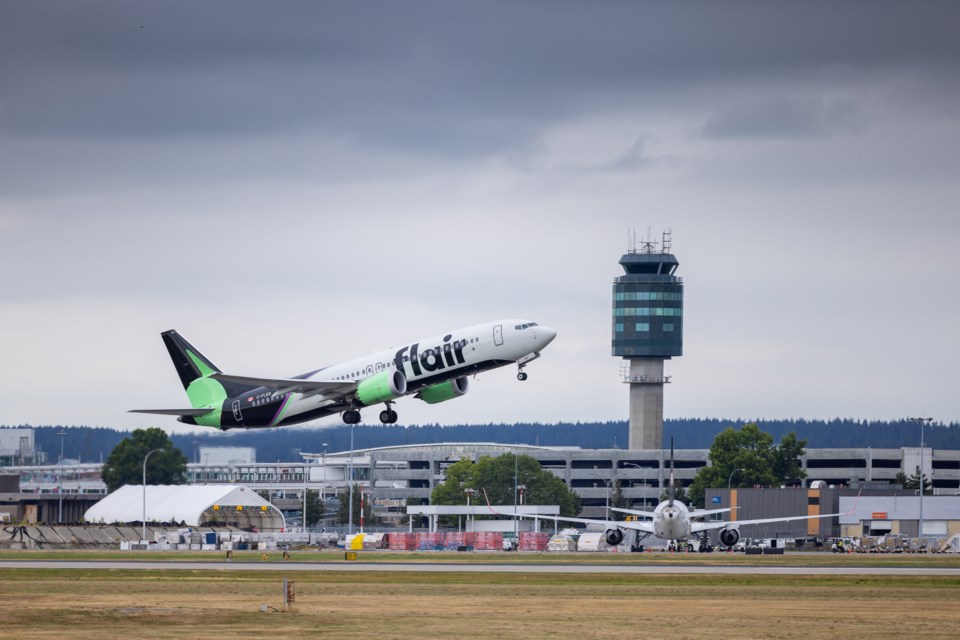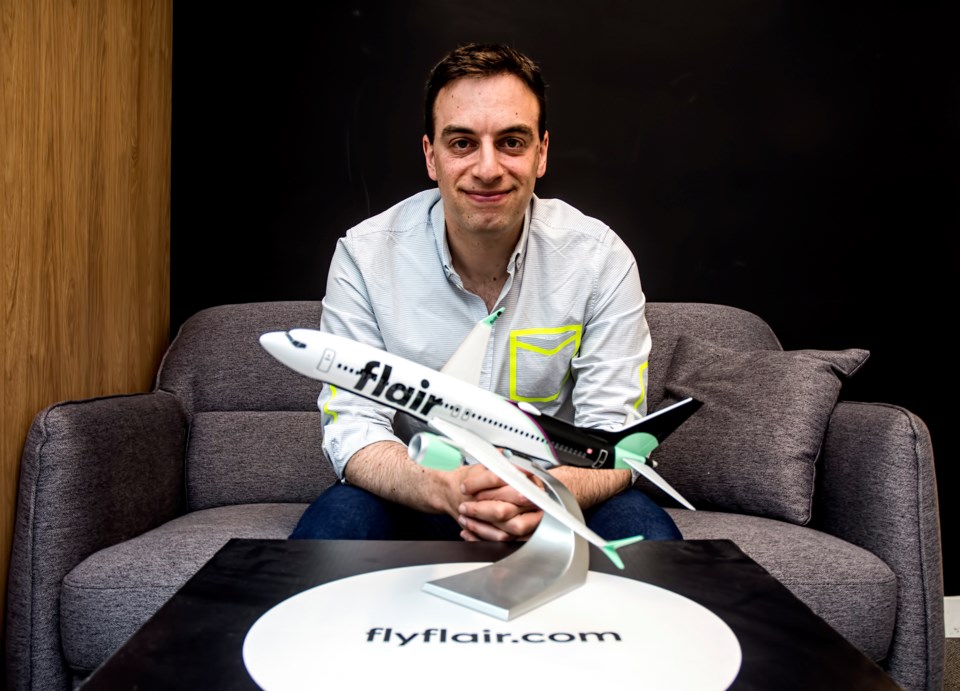Flair Airlines in 2018 held a splashy news conference to announce it was moving its headquarters to Edmonton from Kelowna.
The ultra-low-cost air carrier maintains Edmonton as an operational hub, but what many in the industry do not realize is that key decisions tend to be made in Vancouver.
Interim CEO Maciej Wilk, who has been in the job since last summer when he moved up from chief operating officer, is based in Vancouver. Three other key executives also work out of a 2,500-square-foot office on half of one floor at 602 West Hastings Street: CFO Sumanth Rao; vice-president of commercial operations Eric Tanner; and vice-president of digital Juliana Ramirez.
That’s half of the company’s eight-member executive team. The rest include two in Calgary and two in Edmonton.
“Maciej occasionally speaks to media, but not often,” Tanner told BIV to explain why the company’s top executive was not available for an interview.
“He has delegated most media stuff to me, but I can say he lives in the West End.”
Tanner added that he is not aware of any ongoing corporate search to find a different, permanent CEO, and he said he believed the board is happy with Wilk’s performance.
Wilk’s LinkedIn profile continues identify his role as “interim.”
Sitting in a cramped meeting room in the Vancouver office, Tanner trotted out some statistics to show the extent of his airline’s Vancouver operations.
Flair has 50 staff reporting into its downtown Vancouver office even though there are only enough hot-desk workspaces for 25, he said.
The company plans to soon expand to other space on the same floor, where there is room for 37 workspaces, Tanner added.
The system works for now because staff normally work three days in the office and two days at home, while many travel frequently.
Another sign of Vancouver influence in corporate operations is that two of Flair’s nine board members are based in Vancouver: Blair Jordan and Anthony Dutton, Tanner said.
Vancouver is home to about 70 of the company’s 275 pilots, and about 140 of the company’s approximately 650 flight attendants, he added.
This makes Vancouver the second-largest hub for Flair pilots after Toronto, where about half of Flair’s frontline staff are based.
Flair employs a total of nearly 1,200 people including maintenance workers, call centre staff and others, he said.
“If you look at our general economic impact and activity, it’s significantly larger,” Tanner said.
“We have about 100 ground handlers at YVR [Vancouver International Airport] who work exclusively on Flair, but they’re technically employed by a third party that we work with.”
Flair bases five of its 20 planes at YVR. All are 737-800s to make it easier to swap in new planes or pilots where needed.
Former CEO Stephen Jones, who was also based in Vancouver, told BIV in 2023 that the airline’s goal was to have 50 planes by 2027.
Tanner reiterated that aim earlier this month.
“We’ve had double-digit growth basically every year, for number of seats, which is tied to flights,” Tanner said.
University of British Columbia (UBC) adjunct professor in aviation, John Korenic, told BIV that it is unclear how well Flair is really doing because it is a private company.
“What would be of particular interest is Flair’s profitability, debt level and available capital,” he said.
Tanner would not reveal such details.
Instead, he gave a ballpark estimate for the private company’s 2024 revenue: between $500 million and $800 million, adding that this comes from around 100 flights per day.
Flair has used artificial intelligence “for about a year” to determine pricing, he said.
Its AI considers data for how much capacity Flair has, and how much other airlines have, as well as when flights depart and expected demand.
Projections are made from current data, not historical information that may be skewed by the presence of now-defunct airlines.
“It essentially projects what the expected demand is for a route, and when demand is going to materialize,” Tanner said.
That helps Flair create an anticipated booking timeline. When sales exceed that timeline, prices rise. If sales lag below that timeline, prices fall, he said.
No initial public offering is imminent.
“There’s interest in going public but it just needs to be the right environment and the right time,” he said.
He said Flair’s aim is to improve and generate sustained profit and better financial results than the average airline.
“That’s when an IPO will happen,” he said.
Flair first launched in Kelowna in August 2005 as Flair Air, which largely moved cargo.
Its foray into passenger travel came when it partnered with Winnipeg-based NewLeaf Travel in 2017 to offer low-cost flights.
Some controversy ensued over NewLeaf’s lack of an aviation licence. Flair Air bought NewLeaf later that year, rebranded as Flair Airlines and executives soon realized that their growth ambitions required them to move their headquarters out of Kelowna International Airport, to Edmonton.
“We aspire to be Vancouver’s hometown airline and to be more embedded within the community,” Tanner said.
“We’ve done quite a bit of hiring here in Vancouver, and we’ve developed a great pipeline of talent from organizations in Vancouver.”
The UBC and the British Columbia Institute of Technology have great aviation programs, he added.
“Our strategy is to continue growing in Vancouver,” he said.

Flair’s evolution has included turbulence
Flair expects to increase the frequency of flights out of YVR by 13 per cent next winter, to 102 flights per week, and to up its flight frequency out of Abbotsford International Airport by 38 per cent, to 39 flights per week.
Like other airlines, it has reduced flight frequency to U.S. destinations while increasing them within Canada and to Mexico.
Its growth follows years of tough times for ultra-low-cost airlines.
WestJet launched Canada’s first such airline in 2018 with Swoop, which offered heavily discounted fares and extra fees for frills.
“Swoop was only built to kill Flair,” Tanner said. “In 2022, Swoop started 32 routes, 24 of them overlapped with us with the very same day of week and the very same flight time. So, frankly, Swoop was a predatory tool to try and kill Flair.”
After Swoop pilots won a similar pay package to that in effect for WestJet’s mainline pilots, the airline’s costs rose and WestJet folded Swoop into its own operations in October 2023.
Swoop’s presence may have weakened other competitors.
About four months later, the ultra-low-cost carrier Lynx Air abruptly shut down, leaving thousands of passengers stranded.
Canada Jetlines stopped operating in August last year and was declared bankrupt a month later.
Flair therefore stands as the country’s only ultra-low-cost carrier, offering fares earlier this month for as low as $93 for some June dates for flights between Vancouver and Toronto.
Tanner credited his airline’s survival to better executing its business plan, flying a higher percentage of flights on time and filling its planes with larger passenger loads.
Korenic said the ultra-low-cost carriers’ (ULCC) presence has pulled mainline carriers into adopting parts of that same business model, and to seek more revenue from extra billing.
Air Canada earlier this year started charging for carry-on luggage, for example.
“Ancillary revenue has risen globally, from US$2.5 billion in 2007 to over US$120 billion last year,” Korenic said. “Over the past two decades we have witnessed a narrowing of the differentiation between the ULCCs and legacy carriers.”
Some issues have dogged Flair.
“There have been some issues with respect to ownership, import taxes, safety and air travel complaints,” Korenic added.
A disparate ownership group owns most of Flair, with Miami-based private equity firm 777 Partners holding a decreasing stake that is now less than 10 per cent, according to Tanner.
Korenic said regulators in 2021 were concerned that 777 Partners’ allowable 25-per-cent stake in the airline was in addition to aircraft leases and that this combined might have resulted in the foreign company having what he called an “undue or disproportionate influence.” That matter has since been resolved with 777 Partners reducing its stake, he added.
Court documents last year showed Flair owed the federal government $67.2 million in unpaid taxes related to import duties on its planes.
That prompted the federal government to get a court order to seize and sell Flair property.
Tanner said his airline was able to work out a payment plan and that he has no concern now about Ottawa confiscating planes.
Speculation about financial trouble at Flair arose in March 2023, when Lessor Airborne Capital Ltd. suddenly confiscated four of Flair’s then-22 planes in the middle of the night because the airline was behind on lease payments, prompting a wave of flight cancellations and customer complaints.
Industry insiders, such as former Canada Jetlines CEO David Solloway, told BIV at the time that they would not fly on Flair because they feared flight cancellations or delays.
Korenic noted that Flair also had an incident in 2022 where one of Flair’s planes overshot a runway by 500 feet when landing.
“Nobody was injured but there was some minor damage to the plane,” Korenic said. “An investigation by the Transportation Safety Board of Canada indicated that several factors resulted in the incident, including pilot fatigue and an equipment defect.”
Korenic said he does not think that the incident has created a public perception of safety concerns, but that it was an issue at the time.
Cirium data earlier this month showed WestJet topped all Canadian airlines in April with an 83.4-per-cent on-time record. That bested Porter Airlines’ 81.4-per-cent on-time record. Flair tied with Air Canada, with 80.8 per cent of its flights deemed on time that month.
“Flair operates incredibly on time and doesn’t cancel flights,” Tanner said. “We are really that reliable carrier that Canadians deserve.”
Another business metric shows that it is outpacing peers.
“Our performance has improved dramatically,” Tanner said, pointing to an indicator known in the industry as unit revenue, or revenue per available seat mile.
“In 2024, our unit revenues increased 25 per cent year over year.”
Air Canada, in contrast, reported a 3.4-per-cent increase in revenue per available seat mile in 2024, according to a corporate report.


